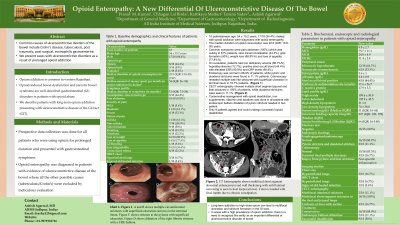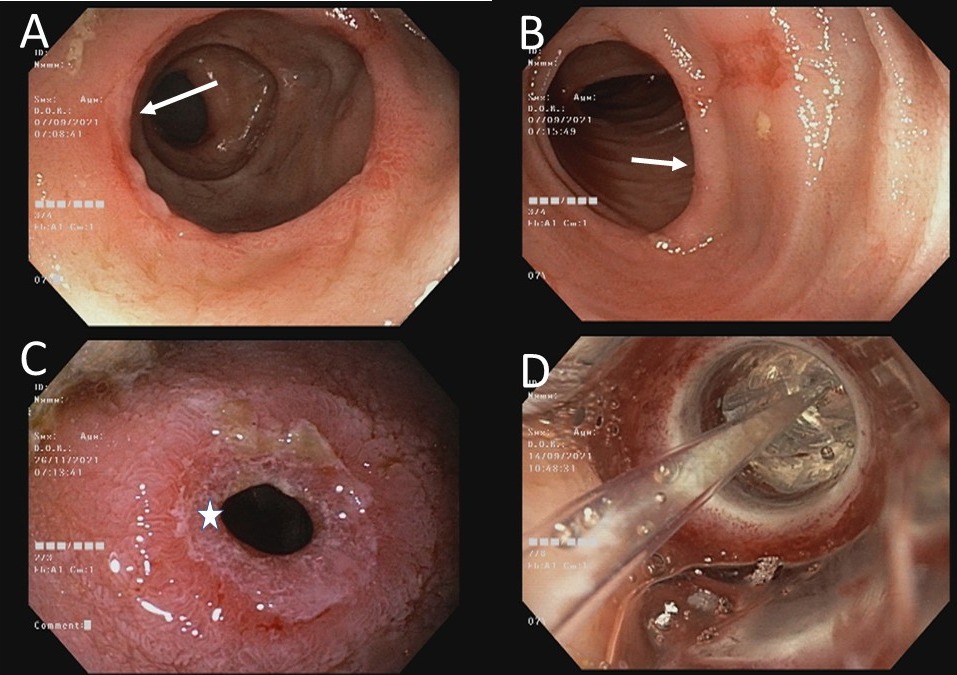Monday Poster Session
Category: IBD
P2187 - Opioid Enteropathy: A New Differential of Ulceroconstrictive Disease of the Bowel
Monday, October 23, 2023
10:30 AM - 4:15 PM PT
Location: Exhibit Hall

Has Audio

Ashish Agarwal, MBBS, MD, DM
All India Institute of Medical Sciences
Jodhpur, Rajasthan, India
Presenting Author(s)
Pranav S Kumar, MBBS1, Chhagan Lal Birda, MBBS, MD, DM1, Kartikeya Mathur, MBBS, MD1, Taruna Yadav, MBBS, MD1, Ashish Agarwal, MBBS, MD, DM2
1AIIMS, Jodhpur, Rajasthan, India; 2All India Institute of Medical Sciences, Jodhpur, Rajasthan, India
Introduction: Opium addiction is common in western Rajasthan. Opioid-induced bowel dysfunction and narcotic bowel syndrome are well-described gastrointestinal (GI) disorders in patients with opioid abuse. We describe patients with long-term opium addiction presenting with ulceroconstrictive disease of the GI tract (GIT).
Methods: Prospective data collection was done for all patients who were using opium for prolonged duration and presented with gastrointestinal symptoms. Opioid enteropathy was diagnosed in patients with evidence of ulcerocontrictive disease of the bowel where all the other possible causes (tuberculosis/Crohn’s) were excluded by meticulous evaluation.
Results: 18 patients[mean age: 54 ± 15.2 years; 17/18 (94.4%) males] with opioid addiction were diagnosed with opioid enteropathy. The median duration of opioid consumption was 22.5 (IQR: 13.8-30) years. Of 18 patients, 8 (44.4%) consumed opium, 9 (50%) consumed opium husk(doda), and 1(5.6%) consumed tramadol tablets with the median expenditure of 54(IQR: 36- 94) dollar per month for opioid purchase. Common symptoms were pain abdomen (100%) which was colicky in 61% patients, slow transit constipation (44.4%), gola formation (50%), weight loss (88.9%%) and loss of appetite (77.8%%). On evaluation, patients had iron deficiency anemia (66.7%%), hypoalbuminemia (72.7%), positive stool occult blood (44.4%) with elevated ESR (90.9%) and CRP levels (90.9%). Endoscopy was normal in 88.9% of patients, while pyloric and duodenal strictures were found in 11.1% patients. Colonoscopy revealed multiple web like strictures with superficial ulceration in terminal ileum in 16.7% patients. CECT enterography showed multiple short segment jejunal and ileal strictures in 100% of patients, while duodenal strictures were seen in 11.1%. Conservative management with opioid deaddiction, iron supplements, rifaximin and laxatives was done in all patients with endoscopic balloon dilatation of pyloric stricture needed in two patient. Only 9 patients agreed and could undergo successful opioid deaddiction.
Discussion: Long-term addiction to high-dose opium can lead to multifocal ulceration and stricture formation in the GI tract. In areas with a high prevalence of opium addiction, there is a need to recognize this entity as an important differential of ulcerocontrictive disorder of bowel.

Disclosures:
Pranav S Kumar, MBBS1, Chhagan Lal Birda, MBBS, MD, DM1, Kartikeya Mathur, MBBS, MD1, Taruna Yadav, MBBS, MD1, Ashish Agarwal, MBBS, MD, DM2. P2187 - Opioid Enteropathy: A New Differential of Ulceroconstrictive Disease of the Bowel, ACG 2023 Annual Scientific Meeting Abstracts. Vancouver, BC, Canada: American College of Gastroenterology.
1AIIMS, Jodhpur, Rajasthan, India; 2All India Institute of Medical Sciences, Jodhpur, Rajasthan, India
Introduction: Opium addiction is common in western Rajasthan. Opioid-induced bowel dysfunction and narcotic bowel syndrome are well-described gastrointestinal (GI) disorders in patients with opioid abuse. We describe patients with long-term opium addiction presenting with ulceroconstrictive disease of the GI tract (GIT).
Methods: Prospective data collection was done for all patients who were using opium for prolonged duration and presented with gastrointestinal symptoms. Opioid enteropathy was diagnosed in patients with evidence of ulcerocontrictive disease of the bowel where all the other possible causes (tuberculosis/Crohn’s) were excluded by meticulous evaluation.
Results: 18 patients[mean age: 54 ± 15.2 years; 17/18 (94.4%) males] with opioid addiction were diagnosed with opioid enteropathy. The median duration of opioid consumption was 22.5 (IQR: 13.8-30) years. Of 18 patients, 8 (44.4%) consumed opium, 9 (50%) consumed opium husk(doda), and 1(5.6%) consumed tramadol tablets with the median expenditure of 54(IQR: 36- 94) dollar per month for opioid purchase. Common symptoms were pain abdomen (100%) which was colicky in 61% patients, slow transit constipation (44.4%), gola formation (50%), weight loss (88.9%%) and loss of appetite (77.8%%). On evaluation, patients had iron deficiency anemia (66.7%%), hypoalbuminemia (72.7%), positive stool occult blood (44.4%) with elevated ESR (90.9%) and CRP levels (90.9%). Endoscopy was normal in 88.9% of patients, while pyloric and duodenal strictures were found in 11.1% patients. Colonoscopy revealed multiple web like strictures with superficial ulceration in terminal ileum in 16.7% patients. CECT enterography showed multiple short segment jejunal and ileal strictures in 100% of patients, while duodenal strictures were seen in 11.1%. Conservative management with opioid deaddiction, iron supplements, rifaximin and laxatives was done in all patients with endoscopic balloon dilatation of pyloric stricture needed in two patient. Only 9 patients agreed and could undergo successful opioid deaddiction.
Discussion: Long-term addiction to high-dose opium can lead to multifocal ulceration and stricture formation in the GI tract. In areas with a high prevalence of opium addiction, there is a need to recognize this entity as an important differential of ulcerocontrictive disorder of bowel.

Figure: Figure 1. A and B show multiple circumferential mild strictures with superficial ulceration (arrows) in the terminal ileum. Figure C shows tight stricture at the pylorus with superficial ulceration. Figure D shows dilatation of the tight fibrotic stricture with a CRE balloon
Disclosures:
Pranav S Kumar indicated no relevant financial relationships.
Chhagan Lal Birda indicated no relevant financial relationships.
Kartikeya Mathur indicated no relevant financial relationships.
Taruna Yadav indicated no relevant financial relationships.
Ashish Agarwal indicated no relevant financial relationships.
Pranav S Kumar, MBBS1, Chhagan Lal Birda, MBBS, MD, DM1, Kartikeya Mathur, MBBS, MD1, Taruna Yadav, MBBS, MD1, Ashish Agarwal, MBBS, MD, DM2. P2187 - Opioid Enteropathy: A New Differential of Ulceroconstrictive Disease of the Bowel, ACG 2023 Annual Scientific Meeting Abstracts. Vancouver, BC, Canada: American College of Gastroenterology.
